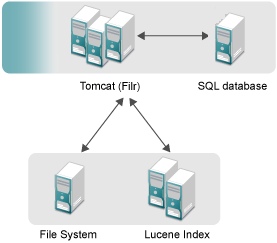1.8 Recommended Hardware Configurations Based on System Performance
Because of the wide variety of content you can store in Filr and the load any given user might put on the system, the recommendations given in this section are only guidelines.
The following sections represent configuration changes that you can make to your Filr installation that affect the amount of users and data that the system can support.
1.8.1 Net Folder Indexing and Synchronization Settings
How you plan to index and synchronize data in Net Folders can affect how much data the Filr system can support.
Performing a full synchronization every hour puts more load on the system than performing an initial full synchronization, then using only Just-in-Time synchronization. (For more information, see Planning the Synchronization Method
in the Novell Filr 1.0.1 Administration Guide.)
Whether you want to index file content also affects the amount of load that is placed on the system.
If you plan to perform a full synchronization and index for Net Folders in your Filr system, ensure that these processes have taken place before users attempt to access the system.
1.8.2 Resource Allocations for the Appliance
Increasing memory and CPU resources for an appliance can sometimes be more favorable than adding another appliance. You might need to adjust CPU and Memory settings for each appliance before you can determine the optimal setting for your environment.
1.8.3 Small Installation Vs. Large Installation
IMPORTANT:You cannot upgrade your Filr system from a small installation to a large installation. Likewise, you cannot upgrade from a large installation to a clustered installation if shared storage has not already been configured. If your Filr system has the potential to grow, you should install Filr in a large installation and create shared storage (as described in Step 9 in Section 2.1, Installing the Filr Appliance). Doing so ensures that you can scale your system in the future if the need arises by adding additional Filr appliances.
The following sections describe guidelines for deploying either a small or large Filr installation.
Small Installation
A small installation, where all Filr components are running on a single Filr appliance, is suitable for systems with no more than:
-
100 concurrent users
Concurrent users are simultaneous connections to the Filr system, from any of the Filr clients.
-
50 total Net Folders
-
30,000 files per Net Folder
-
500 subdirectories per Net Folder
-
500,000 total files spread across all Net Folders in the Filr system (including user Home folders).
IMPORTANT:Ensure that you distribute files across multiple Net Folder Servers, rather than using a single Net Folder server to synchronize all files in the Filr system.

Large Installation
A large installation, where each Filr component is running separately, is recommended for systems with no more than:
-
500 concurrent users per Filr appliance
Concurrent users are simultaneous connections to the Filr system, from any of the Filr clients.
-
100,000 files per Net Folder
-
2,000 subdirectories per Net Folder
-
5,000,000 total file spread across all Net Folders in the Filr system (including user Home folders).
IMPORTANT:Ensure that you distribute files across multiple Net Folder Servers, rather than using a single Net Folder server to synchronize all files in the Filr system.
A basic large installation consists of a Filr appliance, a Lucene index appliance, and a MySQL database. (The MySQL database can be the MySQL appliance that ships with Filr, or your organization’s existing MySQL database. In an enterprise installation, it is recommended that you configure Filr to use your organization’s existing database.)
When you set up a large installation, ensure that you create a shared storage location (as described in Step 9 in Section 2.1, Installing the Filr Appliance). Doing so makes it possible to move to a clustered installation in the future, where there are multiple Filr appliances and Lucene index search appliances.
A clustered installation consists of multiple Filr appliances, multiple Lucene index server appliances, and a single MySQL database appliance or an existing MySQL database.

Advantages of a Clustered Installation
In a clustered installation, you can have multiple Filr appliances and multiple Lucene search index appliances.
-
Provides scalability
As more users begin using the system and more data is added, you can add more Filr appliances to accommodate the load. You can also add a second Lucene search index appliance, which can help improve scalability.
-
Provides fault tolerance
In the event that one Filr appliance goes down, other Filr appliances are there to maintain the system. This is also true with the Lucene search index appliance. It is optimal for your Filr system to have two Lucene search index appliances.